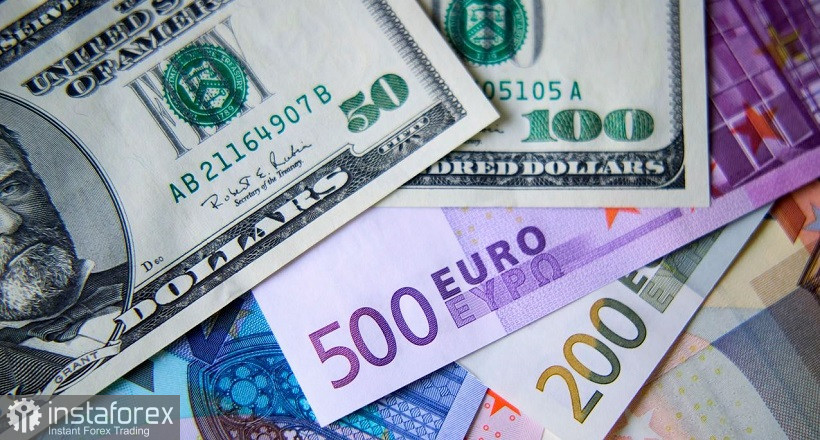The euro-dollar pair found itself in a kind of trap. On the one hand, the prevailing fundamental background contributes to the strengthening of the US currency. The hawkish signals voiced by Federal Reserve Chairman Jerome Powell last Friday made it possible for the greenback to strengthen its positions throughout the market, including in pairs with the euro. On the other hand, the single currency started receiving informational support in doses this week. The cost of natural gas has begun to decline, a compromise has been reached between Serbia and Kosovo in the Balkans, and hawkish rumors are growing around the European Central Bank. All these fundamental factors allow bulls to organize upward counterattacks.
In general, in order to develop the downward trend, EUR/USD bears need to go below the 0.9900 mark, while bulls need to settle not only above the parity level, but also above the 1.0100 mark (in this case, we can count on further growth in the 1.0150-1.0280 area). However, the contradictory fundamental picture keeps the pair within the 100-point range. Bears cannot enter the area of the 98th figure, and bulls hardly hold their positions above the parity level.

Let me remind you that at the end of last week, the euro was under the strongest pressure amid a rapid rise in gas prices on European stock exchanges. More than 3,500 dollars have already been asked for a thousand cubic meters of blue fuel. Electricity prices in France and Germany also rose to new records. In particular, the French contract for 2023 increased by 13% to 1,022 euros per megawatt hour. Gas prices were rising amid market fears that Europe will experience a shortage of natural gas during the autumn-winter period, as Gazprom consistently reduces its supplies to the European region. The next jump in prices occurred after the company's statement about the complete shutdown of the SP-1 due to repairs (previously - for a three-day period).
However, today there is a decrease in gas prices in Europe. This happened after statements by German representatives that Germany's gas storage facilities are "filling up faster than planned." It is expected that they will be filled by 85% next month, and completely in October.
In addition, the euro reacted positively to the compromise between Serbia and Kosovo. Let me remind you that at the end of July, Pristina decided to introduce temporary documents that Serbian citizens should receive upon entry. Also, according to the new rules, they will have to re-register cars and replace license plates issued in Serbia to Serbs living in the north of Kosovo. The situation escalated so much that the media began to be full of headlines about possible armed clashes. As a result, the parties "went to the corners of the ring" until September 1. On the eve of autumn, politicians announced that they were not going to make any compromises. Even on Friday, there were quite bellicose statements and gloomy forecasts. But on Saturday it became known that Serbia agreed to cancel its entry-exit documents for holders of Kosovo identity cards, while Kosovo agreed not to introduce them for holders of Serbian identity cards. And although the related issue (about license plates) is still unresolved, many have breathed a sigh of relief: another surge of tension in the Balkans has been extinguished.
Another fundamental factor also provides indirect support for the euro. According to Reuters, the ECB at its September meeting is ready to discuss the issue of raising the rate by 75 basis points "due to the deterioration of the inflation forecast." According to unnamed sources, representatives of the ECB are ready to apply a more aggressive pace of tightening monetary policy, even despite the impending recession in the eurozone. In their opinion, this factor "will not slow down or stop the process of normalization of ECB policy."
I repeat – this is unofficial information, but it was published by a fairly reputable media. Therefore, it still made its contribution to the process of a corrective rollback of EUR/USD.
By the way, the chief economist of the ECB, Philip Lane, just spoke. He rather vaguely commented on the prospects for tightening monetary policy: according to him, a steady pace is important here – "neither too slow nor too fast." He also said that in the near future, inflation in the eurozone will remain at a high level.
Thus, the euro quite reasonably and argumentatively showed character against the dollar by organizing a corrective counterattack. But remember that EUR/USD bulls are not able to reverse the downward trend: the greenback's position has noticeably strengthened after Friday's speech by the head of the Federal Reserve. Moreover, apparently, bulls are unlikely to be able to stay above the parity level for a long time. Therefore, it is still advisable to use upward momentums to open short positions. The downward targets are the same: 1.0000 (with the price rising above parity and the momentum fading around 1.0050 – the Tenkan-sen line on D1), 0.9950 and 0.9910 (the lower line of the Bollinger Bands on the same timeframe).





















